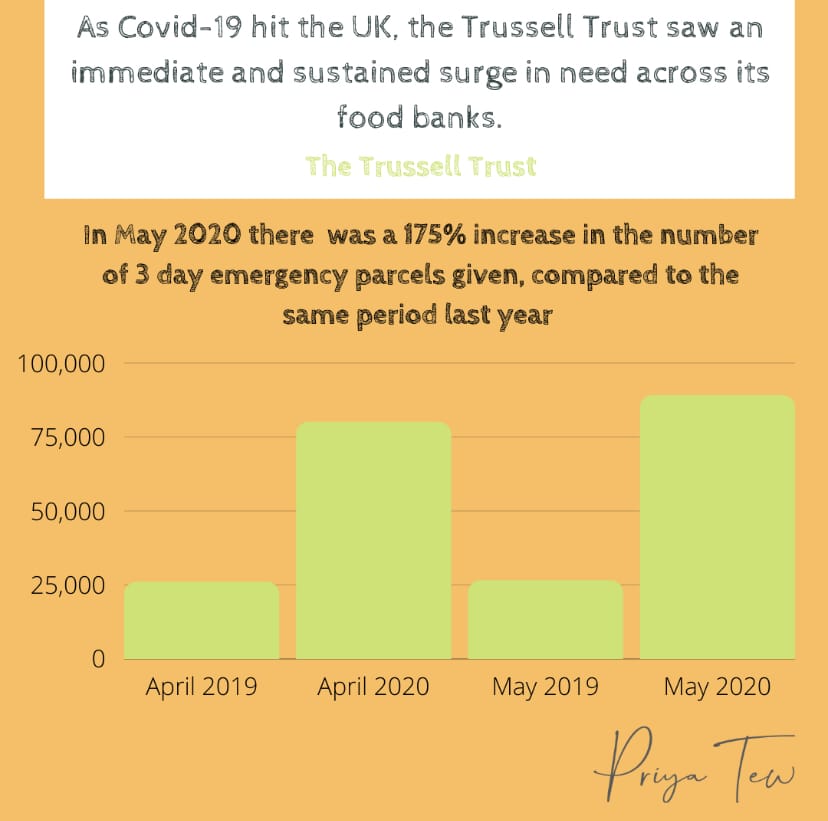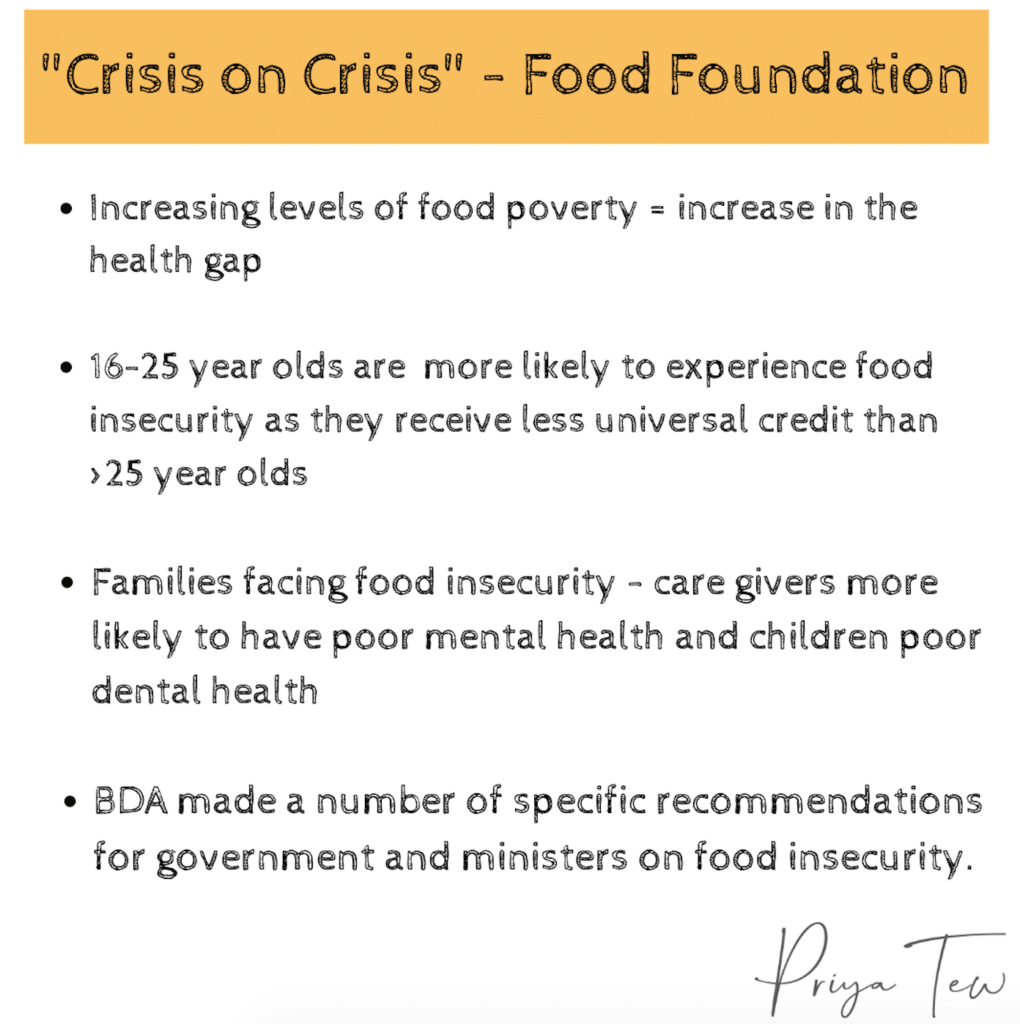Alongside all the loss that has been felt by this pandemic, it has also highlighted and increased health inequalities, food insecurity being one that is described as “a crisis within a crisis”. Unfortunately, food insecurity / food poverty is nothing new. It has been around in the UK for a number of years and started making headline news around 2014 but it has had a significant rise due to this pandemic, with the number of families coming to food banks doubling – this completely unprecedented and not right [1]. Food banks in the Independent Food Aid Network (IFAN) report a 175% increase of those in need in May 2020 compared to May 2019 [2]. The first national measure of food insecurity in the UK is being conducted this year will provide key data to demonstrate the scale of this issue.

So what is food insecurity?
Food insecurity is the state of being without reliable access to enough affordable, nutritious food, divided into three categories: [3]
- Mild food insecurity: Worrying how you will get food
- Moderate food insecurity: Limiting quality & quantity of food as well as skipping meals
- Severe food insecurity: Living in hunger
Food insecurity is an affirmative response to one of three questions:
- In the last 12 months, did you or other adults in the household ever cut the size of your meals or skip meals because there wasn’t enough money for food?
- In the last 12 months, were you ever hungry, but didn’t eat, because there wasn’t enough money for food?
- In the last 12 months did you or other adults in your household ever not eat for a whole day because there wasn’t enough money for food?
Food poverty is commonly defined as ‘the inability to acquire or consume an adequate or sufficient quantity of food in socially acceptable ways, or the uncertainty that one will be able to do so’, more typically associated to famine or natural disasters.
Most common reasons or situations which increase the risk of food insecurity?
Low income – 54.9%, benefit delays 23.9% or benefit changes 21.1% [4].
It is important to mention that there is a significant amount of bias around why someone might require such service but the figures show it is not a simple problem and the pandemic has highlighted how easy it is for those working with low income to slip into food insecurity. For many families this has been a real problem, 32% of families have lost income due to the pandemic thus having to turn to food banks for basic foods [5]. This also takes a toll on the caregivers mental health. In addition, those who are ages under 25 years old receive only £342.72 per month. This is a challenge to pay rent, bills and have an adequately nutritious diet. [6] Young homeless – centre point reported a 276% increase of 16-25 year olds were severely food insecure, requiring immediate action by the health care teams [7]
4.7 million UK adults (9%) have experienced food insecurity in the past 6 months and 2.3 million UK children live in households that have experienced food insecurity in the past 6 months (12% of households with children). Covid-19 has dramatically widened inequalities in food security and nutrition [8].

The UK’s poorest households struggle to afford to meet the government’s recommended guidelines on a healthy diet, leaving them more at risk of obesity and heart disease, an annual audit has revealed. The poorest 20% of UK households would need to spend 39% of their disposable income on food to meet Eatwell Guide costs. This compares to just 8% for the richest 20%. [9]
Existing inequalities in the ability of families to buy enough healthy food had been highlighted during the coronavirus pandemic, in addition the mean price of fruit and vegetables continues to soar – it cost £9.39 per 1,000 calories in 2019, having risen every year since 2016 – while the price of food and drinks that are high in sugar, salt and/or fat has remained stable at £3.54 per 1,000 calories [9].
Highest levels of Food Insecurity faced is face by those who already suffer from other inequalities:
In January 2021, those who are significantly limited by their health or disability were five times more likely to face food insecurity than those without health care needs. Before the pandemic they were three times more likely [10].
The IFS reported that food and social care sectors employees as a result of low wages (<£10 per hour) are likely to be faced with increased levels of food insecurity. In the past 6 months (August 2020 to January 2021), 14% of food sector workers have been food insecure compared with 9% of non-food sector workers [10].
Due to longstanding inequalities BAME groups have been disproportionately affected by the pandemic and are twice as likely to be food insecure as White British persons. In January, 20% of BAME households had experienced food insecurity in the past 6 months compared with 9% of White British households [10].
How to access a food bank?
Food banks work with variety of frontline professionals, such as doctors, health visitors, social workers and the Citizens Advice, who make referrals to the food bank using a voucher. The food bank and referral agency use the voucher to gather some basic information. This will help them to identify the cause of the crisis, offer practical guidance and prepare suitable emergency food. Once you have been issued with a voucher, you can exchange this for a minimum of three days’ emergency food at your nearest food bank centre.
What can we do to help?
There is still a clear need for long-lasting policy measures to be implemented to ensure everyone has access to a healthy diet. As a Dietitian we follow BDA and encourage the pressure on the government to take action:
“UK Government and local authorities must take urgent action to lift people out of food poverty and prevent others from falling into food poverty. This should include enshrining a “Right to Food” in UK law.”
The BDA Fact Sheet – “Right to Food” in UK law.” [11] Is a brilliant resource for anyone who wishes to see this in more detail. All health professionals should be aware of these very real barriers to reaching a nutritionally adequate diet and look to screen for food insecurity and signpost those in need to help.
Following and engaging in campaigns like the End Child Food Poverty campaign by Marcus Rashford [12] will help to keep raising national awareness about child food insecurity in the UK. After a successful campaign for food vouchers to be extended over the summer holidays, the Government has so far delivered on extending holiday provision in 2021 and increasing the value of Healthy Start vouchers for low-income young families. However, there is still more to be done, the campaign asks for a permanent expansion of Free School Meals and Healthy Start to all children from households where a parent or guardian is in receipt of Universal Credit or equivalent benefits has not yet been actioned.
Food bank charities require our support by donating nonerasable food, toiletries, household items, feminine products and baby supplies, donating money via the website or time by volunteering [13]. There is still a clear need for long-lasting policy measures to be implemented to ensure parents and children have access to a healthy diet.
No person should be living in hunger, we can all offer something to help, now more than ever it’s become increasing important to look after those most vulnerable. The UK is the 7th most wealthy country in the world yet there are people facing food insecurity and in a state of hunger. Everyone has the right to food.
References :
[1] https://www.foodaidnetwork.org.uk/ifan-data-since-covid-19
[2]https://www.trusselltrust.org/news-and-blog/latest-stats/end-year-stats/
[3] https://enuf.org.uk/sites/default/files/resources/foodinsecuritybriefing-may-2016-final.pdf
[4] https://www.trusselltrust.org/wp-content/uploads/sites/2/2017/07/OU_Report_final_01_08_online2.pdf
[6] https://www.food.gov.uk/sites/default/files/media/document/fsa-food-insecurity-2020_-report-v5.pdf
[7] https://centrepoint.org.uk/media/4773/a-year-like-no-other.pdf
[8] https://foodfoundation.org.uk/wp-content/uploads/2021/03/FF_Impact-of-Covid_FINAL.pdf
[9] https://foodfoundation.org.uk/wp-content/uploads/2020/09/FF-Broken-Plate-2020-DIGITAL-FULL.pdf
[10] https://foodfoundation.org.uk/wp-content/uploads/2021/03/FF_Impact-of-Covid_FINAL.pdf
[11] https://www.bda.uk.com/resource/food-poverty.html
[12] https://endchildfoodpoverty.org/
[13] https://www.trusselltrust.org/get-involved/ways-to-give/donate-food/